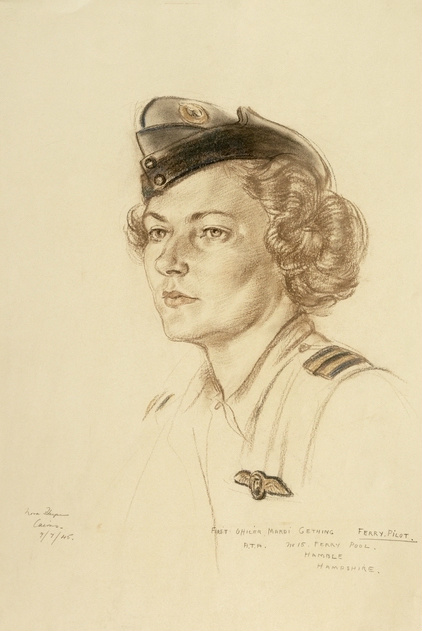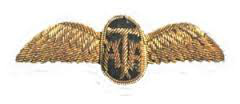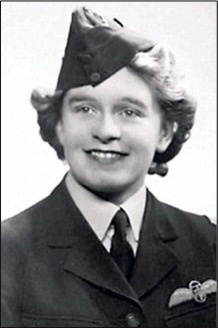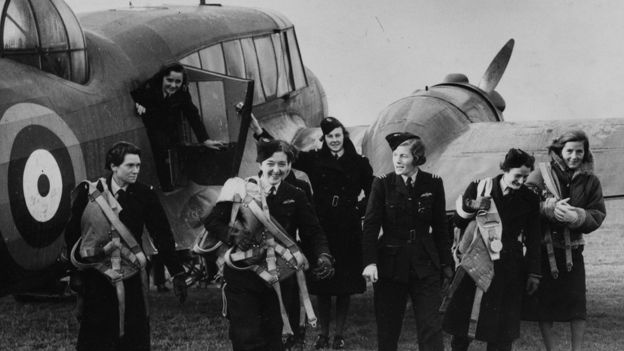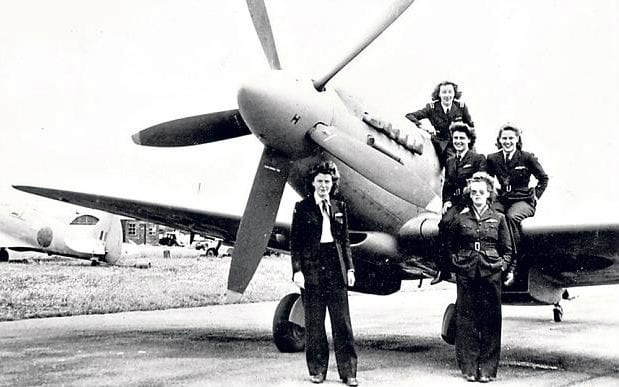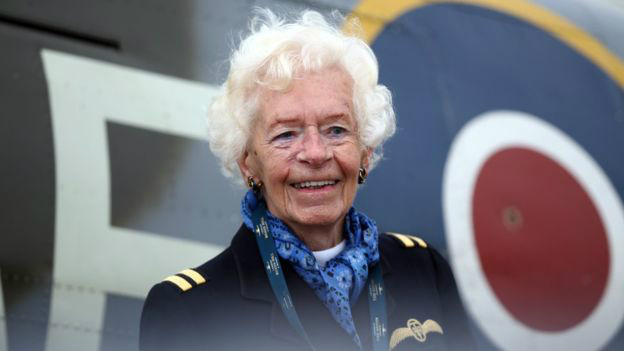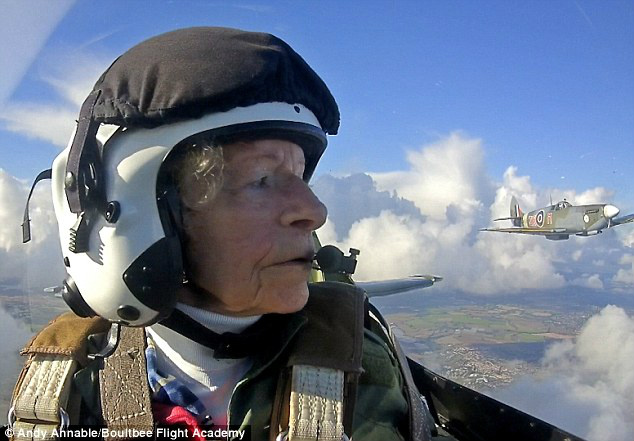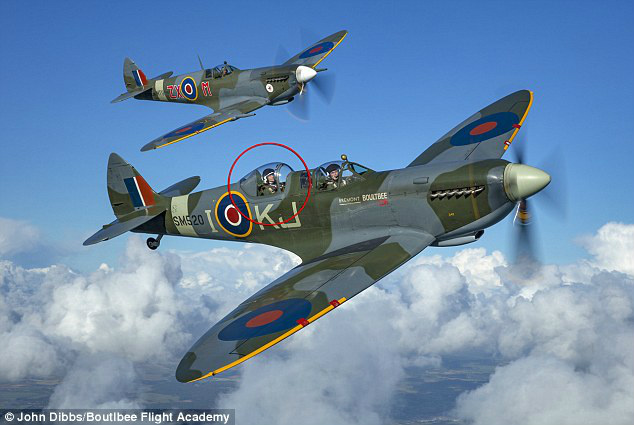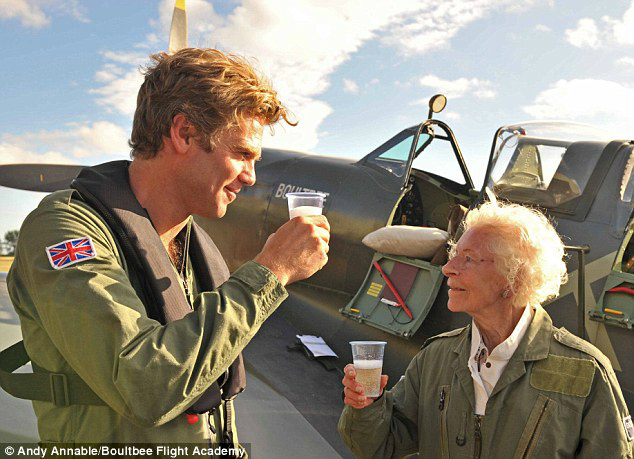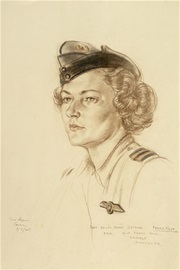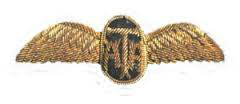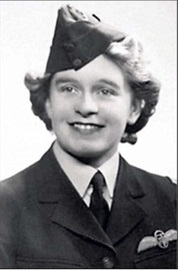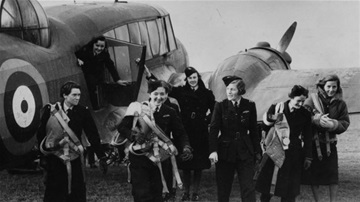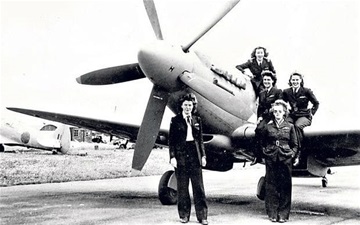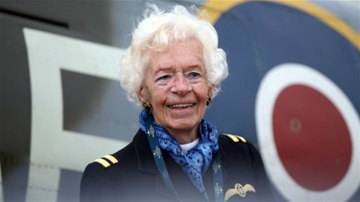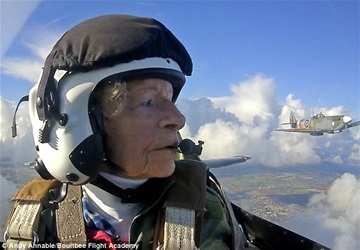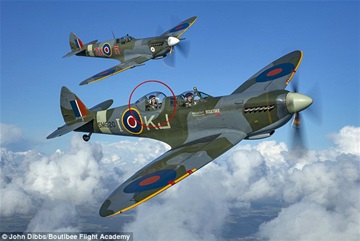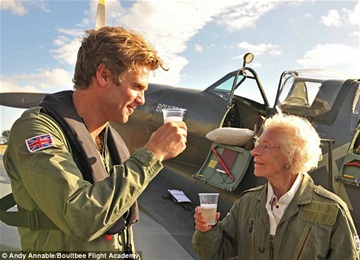The Air Transport Auxiliary (ATA)
MARDI Gething, the only Australian among about 80 women pilots who flew with the Air Transport Auxiliary in Britain during World War II, died in 2005. She was 84.
The wartime role of ATA pilots was to ferry military aircraft from British factories to RAF air bases around the country for use by operational squadrons. They flew in radio silence and often in bad weather, dodging balloon barrages and at risk of attack by enemy fighters.
Between 1942 and 1944, Mardi ferried 42 different aircraft types, including fighters such as Spitfires, Hurricanes, Tempests, Typhoons and Mustangs, as well as Wellington and Blenheim bombers.
Margaret "Mardi" Helen Gepp was born in Melbourne, the youngest child of Sir Herbert and Lady Jessie Gepp. Perhaps the 10 years separating Mardi from her next sibling contributed to the freedom of choice allowed her by her hitherto strict father. Light aircraft flights with him sparked her lifelong dedication to aviation.
By her own account, Mardi was not a highly committed scholar at Ivanhoe Girls Grammar School and Merton Hall. However, despite her diminutive size she was a gifted sportswoman, excelling in events as diverse as diving (she was a schoolgirl champion) and dressage on her beloved 17-hand horse, Royal Archer.
Soon after leaving school in late 1938, Mardi, with eldest sister Kathleen as companion and chaperone, embarked for Britain to be "finished" by a social season in London that was to culminate in her presentation at court. However, on the voyage she became close to RAE Flight Lieutenant Richard Gething, the navigator and relief pilot of a Wellesley bomber that had just set a new non-stop long-distance flight record of 11,526 kilometres from lsmalia in Egypt to Darwin.
On arrival in Britain, Mardi switched her plans for a London season; with permission from her father, she enrolled in a flying school. After earning her A pilot's licence, Mardi's further training was interrupted by the approach of World War II.
No passages to Australia were available via the Suez Canal or the Cape, so Mardi and Kathleen took a ship to New York, and then travel led by train to San Francisco, where they stayed for three months until berths across the Pacific became available.
Mardi took advantage of this delay to enrol in night instrument flying and instructor's courses at the Boeing School of Aeronautics. Despite having gained all the necessary qualifications, she was too young to officially qualify for her B pilot's licence, commercial licence and instructor's rating until late that year, back in Australia, when she turned 19.
Mardi's plans to train other young Australian women in flying and to organise a flying nurses‘ corps were cut short when Richard telephoned from Canada, where he was involved in setting up the Empire Air Training Scheme, to ask her father for her hand in marriage. Mardi and Lady Jessie soon were on their way to Toronto, where Mardi and Richard were married in May 1940.
At the end of 1941, Richard was posted briefly to the Air Ministry in London, and then to Karachi. He spent the remainder of the war in the Far East, his last war posting involving army liaison in Burma.
Left behind in Britain, Mardi applied to join the ATA but was initially rejected because she was considered too short. But her persistence won out.
Towards the end of the air war, Mardi's ferry pool was disbanded and she returned to Australia, where in early 1945 she joined the crew of Lancaster bomber "G for George" (now on display at the Australian War Museum in Canberra) as public relations officer on its tour of Australia to raise money for the Third Victory Loan Appeal.
In the 1940s, Mardi also worked briefly for The Age as a society reporter.
When Richard returned to the Air Ministry in late 1945, Mardi joined him to resume life together in a small village south of London. Their two children were born there in 1947 and 1949, and Mardi continued her flying career as a member of the RAF Volunteer Reserve until Richard was posted for two years to Singapore.
Later the family was stationed in Northern Ireland and then in Scotland before Richard, now an air commodore, worked a final stint at the Air Ministry in London.
In 1959, the family returned to Australia, settling at Red Cliffs, near Mildura, where Mardi's and Richard's interests turned from powered aircraft to gliders. They became enthusiastic members of the Sunraysia Gliding Club, joined during school holidays by their children, who became solo pilots soon after their 15th birthdays.
Mardi, a keen member of the Australian Women Pilots Association, became the first female licensed gliding instructor in Australia, and for a time held the women's altitude record for a glider flight (13,000 feet).
Mardi and Richard both became nationally accredited gliding instructors and taught new club level instructors around Australia.
In 1966 they moved to the Gepp family property at Kangaroo Ground near Melbourne, from where they continued their Australia-wide gliding activities. In retirement they travel led widely overseas and in Australia, visiting war time and service friends and colleagues and dropping in on any gliding centre on their route.
When Richard died in May last year, their wonderful partnership in aviation had lasted more than 64 years.
Mary Ellis
A 100-year-old woman who flew spitfires during the Second World War celebrates her centenary by getting behind the controls again
Mary Ellis was in a select gang of female pilots who flew during World War II. She has now celebrated her 100th birthday by flying a Spitfire over West Sussex in the UK.
Mrs Ellis flew next to one of the Spitfires she was in more than 70 years ago as one of the 'ATA Girls', the select gang of female pilots who flew Britain's fighters during the war.
Over her shoulder is one of the actual Spitfires she flew during her 1,000 flights as a First Officer with the Air Transport Auxiliary. Mary was handed the controls of the 275mph twin- seater as it swooped over West Sussex.
After about 15 minutes, she turned for home, and told her co-pilot Matt Jones: 'Goodwood on the nose, you have control '. Then she settled back to enjoy the ride back to base.
Earlier, Mary watched in delight as Spitfire MV154 took its place beside her in an extraordinary airborne tribute. It was a plane she had delivered to RAF Brize Norton from Southampton on September 15, 1944, and it hides a sentimental secret. At the end of the 25-minute wartime flight, she signed the cockpit, scrawling her maiden name Wilkins and the initials ATA.
She hoped her tag might be spotted by a handsome pilot and lead to a wartime romance – although the impulsive act, a career one-off, didn't bag her a boyfriend.
Mary, originally from Oxfordshire, had her first flying lesson in 1938, and flew for pleasure until 1941 when she heard a BBC radio appeal for women pilots to join the auxiliary service and so release male pilots for combat duty.
Speaking at a surprise birthday party Mary said: 'The war was a challenge and one had to do something about it. I went on and on until I flew everything. I love the Spitfire – it's my favourite aircraft, it's everyone's favourite, it's the symbol of freedom.'
For four years she ferried warplanes from factories to frontline squadrons. The 166 women of the ATA – about one in eight of the total – have been dubbed 'The Female Few', echoing Winston Churchill's description of the RAF airmen who fought in the Battle of Britain.
Mary was usually found at the joystick of a Spitfire or a Hurricane but ultimately flew more than 50 types of aircraft, logging 1,100 hours of flight, much to the astonishment of some colleagues.
As she sat on the airfield ready to deliver her first Spitfire, the mechanic standing on the wing asked how many of them she'd flown. When she said it was her first, he was so startled he fell right off. The largest aircraft she flew solo was the Wellington bomber.
After landing at an East Anglian airfield, Mary was greeted by the ground crew who asked where the pilot was. 'I'm the pilot,' she said. They insisted on searching the aircraft before they believed her.
It was dangerous work. Mary was sometimes ordered to move combat-damaged planes that were not officially fit to fly, but had to be taken for repairs. She crash-landed twice and was shot at once.
Fourteen of her fellow ATA female flyers lost their lives, including aviation pioneer Amy Johnson.
Mary – who to this day needs no spectacles, nor a walking stick – was one of the last six women serving in the ATA when it disbanded after the war. She remained a private pilot and then became managing director of Sandown Airport on the Isle of Wight. She married Don Ellis, a fellow pilot, in 1961, but was widowed in 2009.
Matt Jones, who flies Spitfires for Goodwood-based Boultbee Flight Academy, reunited Mary with MV154 after first meeting her in 2015. He conspired with the plane's current owner, pilot Maxi Gainza, to bring it to the UK from its base in Bremgarten, Germany.
He said: 'I gave Mary control of our Spitfire. I wasn't sure where we were but Mary was very clear. She pointed us towards Thorney Island, up through the Witterings, flew on to Selsey Bill and then Bognor Regis, never losing a foot of altitude.
'She showed me precisely how she was able to deliver all those aircraft with just a map, a compass and a stopwatch. I was utterly humbled by a superior aviator who also happens to be 60 years my senior!'
